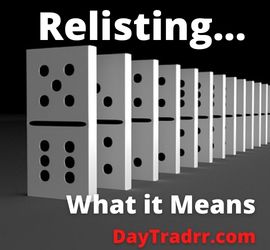What Is a Stock Relisting Vs Delisting?
 Relisting and delisting are procedures for adding and removing securities from a stock exchange. Companies may be delisted willingly or as a result of regulatory issues. A relisting is the same as a fresh listing or an initial public offering (IPO).
Relisting and delisting are procedures for adding and removing securities from a stock exchange. Companies may be delisted willingly or as a result of regulatory issues. A relisting is the same as a fresh listing or an initial public offering (IPO).
A firm that has been relisted is one that has returned to the public market after a time of not being quoted on an exchange. Companies may delist for one of two reasons. Either they fail to meet the exchange’s listing standards, or they voluntarily withdraw their shares from the market. For example, Dell delisted voluntarily from the Nasdaq Exchange in 2013. Then, Dell relisted on the NYSE in 2018.
A stock may be subject to delisting for a variety of reasons. For example, impending insolvency, failure to file required financial reports, or share values that fall below the exchange’s minimum threshold. However, the firm can resolve those issues, fulfill the listing criteria, and file for relisting its shares again. Often, relisting a firm elicits conflicting reactions from investors. It can result in only limited success during its second tenure on the market depending on the initial deficiency.
When a stock is delisted from a major exchange it is relocated to the OTCBB or pink sheets. You still own the shares you purchased, but you should decide whether you want to keep or sell them. Investors should give careful consideration to the issues the business is experiencing.
Relisting – A Closer Look
Relisting a company follows the same criteria as a fresh listing or an initial public offering (IPO). However, in contrast to a hot initial public offering (IPO), a relisted business is typically met with mixed emotions. Past history may even drag down share prices. When examining the relisted shares, investors will likely consider the company’s earlier missteps. The factors that precipitated the delisting could remain a factor and the stock’s attractiveness would likely dwindle even more. For example, difficulties in the income statement such as declining sales or profits. Few firms achieve comparable highs or values after relisting shares. However, it is far from a death sentence. After delisting from a major exchange, many firms may and have returned to compliance. Then, they relisted on a different exchange such as the Nasdaq.
Relisting vs Delisting
Delisting is the removal of a publicly traded corporation from the stock market. Delisting may be done voluntarily or as a consequence of insolvency, mergers, or noncompliance with listing rules. When the advantages of being publicly traded exceed the drawbacks and costs, some firms choose to voluntarily revert to private ownership. Companies listed on the Nasdaq Stock Market, for example, must fulfill standards for continuous listing. If a firm fails to meet the basic conditions for continued listing, Nasdaq will delist it.
Delisting – A Closer Look
Company delisting is the process of removing or delisting a listed company’s shares from stock exchanges. While it may seem serious and frightening, corporate delisting is not necessarily a terrible thing. The process may also happen willingly, at the firm’s desire. There are two common scenarios in which a company’s shares might be delisted from a stock exchange.
Voluntary delisting
In this case, the firm submits a formal request to have its shares delisted from a particular stock exchange. The corporation might do so for a variety of reasons. For example, if a firm intends to merge with another firm. The management may officially request that its shares be delisted from the markets.
What happens to your shares? When a firm announces voluntary delisting, it buys back the public shares via a process known as reverse book building. As a result, you may recover your investments in a business that is delisted voluntarily by simply offering your shares for sale back to the firm at the cut-off price. You, on the other hand, may continue to own your shares. However, since the firm has been delisted from the markets, you may have difficulty selling your shares. However, if you can find a buyer on the over-the-counter (OTC) market, you may still sell your shares and recover your investment or even make a profit.
Compulsory delisting
When an exchange forces the delisting of a company’s shares, the procedure is known as forced delisting. A firm that does not comply with the listing standards or the exchange’s regulatory requirements is usually delisted in this manner. However, there may be other causes, such as a lack of market capitalization or a poor stock falling below a minimum threshold.
What happens to your shares? In the case of mandatory delisting, the company’s promoters are required to purchase back the shares from the public. The value at which the repurchase will occur, however, is set by an impartial assessor rather than via the reverse book building process.
Frequently Asked Questions
What is relisting?
The opposite of delisting, relisting is the process through which a delisted company lists its shares again on the stock exchange for trading. However, the re-listing process is subject to strict guidelines and oversight from the exchange in question. The guidelines tend to differ based on the way the company was delisted.
- Voluntary delisting: A company that’s delisted its shares voluntarily can make a request for relisting. This is after meeting all the requirements and waiting the appropriate amount of time as specified by the exchange.
- Compulsory delisting: A company that’s been compulsorily delisted can make a request for relisting. Again, this is after meeting all the listing requirements and serving the probationary period as specified by the exchange.
What happens to your investment when a company relists?
When a company’s shares are relisted on the stock markets, they become accessible for trade to the general public. This is particularly advantageous if you opted to keep your investment in the stock of a firm whose shares were delisted since it effectively allows you to leave and recoup your investment.
Is relisting a stock common?
It is possible for a delisted stock to be relisted on a major market, although this is uncommon. The delisted firm would have to avoid bankruptcy, resolve the problem that caused the delisting, and again comply with the exchange’s requirements. More often than not, a delisted firm falls bankrupt, and the delisted shares become worthless. The firm may be bought out of bankruptcy by a private owner or forced to liquidate. The firm may potentially reorganize and ultimately go public through an initial public offering (IPO). In that case, fresh shares are issued to new owners. While the corporation remains the same, the original shareholders’ money is usually lost in the event of bankruptcy.
What is Relisting vs IPO
Companies can get relisted on stock exchanges by fulfilling the listing criteria once more and filing the appropriate paperwork again. In essence, a relisting is almost identical to a new listing or an Initial Public Offering – IPO.
Up Next: What Is an Interest Floor Rate?
 An interest floor rate for interest-bearing securities is an agreement between the issuer and the investor that the floating rate of return will not fall below a specified floor level over an agreed period of time. For an adjustable-rate mortgage, it is the minimum interest rate possible over the life of the mortgage loan.
An interest floor rate for interest-bearing securities is an agreement between the issuer and the investor that the floating rate of return will not fall below a specified floor level over an agreed period of time. For an adjustable-rate mortgage, it is the minimum interest rate possible over the life of the mortgage loan.
A floor rate is an agreed-upon figure in the lower range of rates associated with a variable rate loan instrument or derivative. In derivative contracts and loan agreements, interest rate floors are used. This is in contrast to a maximum limit on interest rates or a cap. Generally, a floor rate is the lowest interest rate available on a variable-rate credit package. These floors are often employed in derivative agreements to ensure that the rate of return never falls below a specified threshold.
In the adjustable-rate mortgage (ARM) market, interest rate floors are often employed. An interest rate floor is often included when an ARM is issued since it prohibits interest rates from changing below a certain threshold. This minimum is often used up-front as a teaser rate to entice new customers. Later in the life of the loan, it is intended to at least pay any expenses related to the loan’s processing and servicing.




